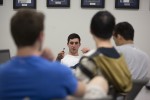Intrigued by how the brain processed language and thought, Shayna Lurya came to UCLA to study linguistics and psychology. But instead of limiting her studies to the human brain, she soon absorbed herself into something a little less human: computers.
“If a computer can understand human language, can they think like a person? That’s the idea,” Lurya said.
Lurya, a third-year linguistics and psychology student specializing in computing, is one of about 50 members in the recently formed Artificial Intelligence group at UCLA, a special interest group within the nationwide organization Association for Computing Machinery.
Artificial intelligence is the study of humanlike intelligence exhibited by machines and software.
“The goal of artificial intelligence is to get computers thinking and sentient,” Lurya said.
Third-year cognitive science students Omri Raccah and Cody Kommers decided to make an official group at UCLA catered to the the field of artificial intelligence.
Raccah said the ultimate goal of the group is to have people with an interest in artificial intelligence come together to work on projects and specialize in their area of computing. The projects will eventually be uploaded onto websites and be available to the public.
“I was already interested in learning how the brain works,” Raccah said. “The impact artificial intelligence is going to have draws me to the field.”
Coincidentally, Raccah and Kommers worked in the same lab, a place where they shared and discussed ideas of an artificial intelligence group on campus. Kommers brought up the idea in the middle of winter quarter and soon the infant group formed, attracting students of many different backgrounds.
“I was always interested in the way psychology works and analyzing human behavior,” Kommers said. “But then I realized that the step beyond that was not just describing human behavior, but implementing it in artificial intelligence.”
Raccah added that experience in artificial intelligence is appealing to several job markets in our technology-driven era.
The pair decided to split the artificial intelligence group into three different subgroups they found most relevant to the field: gaming, natural language processing and machine learning.
Each subgroup has different assignments and projects. Individuals in each group will be further split up depending on their strengths, each person contributing to one large project.
As well as being president of the club, Raccah helps lead the gaming group. He said they were planning to develop an iOS game for the iPhone. They decided to program the game in Python, a widely-used programming language, after all of the members took free online courses and are starting to hone in on designing their game.
Kommers said the natural language processing group is going to be working on a project more academically research-focused than the others: an algorithm that will break down natural language into parts of speech.
As leader of the natural language processing group, Lurya said they were also considering creating an app that mines data utilizing an algorithm which extracts information from a web page to help students sign up for classes.
“Ever since I was little, I’ve always been freaked out by the idea of a smart computer. So I thought if you can’t beat them, join them,” Lurya said, laughing.
Lurya said she believes everyone should have some computing knowledge, and the artificial intelligence group was a good opportunity for her to learn more.
But Raccah suggests that people learn some basics before joining.
“We’re not opposed to people new to programming coming in, but our goal is not to teach people how to program,” Raccah said.
Dhavalkumar Suthar, a computer science graduate student, guides the machine learning group and is currently the only graduate student in the group.
Machine learning is about having a machine learn and adapt, similar to how humans learn through new experiences, Suthar said.
The scientists behind artificial intelligence and machine learning focus on programming computers to do what humans can do, such as understanding and processing visual information, he added.
The Artificial Intelligence group had planned to include computer vision as a fourth group, but ran into more difficulties than expected.
“Computer vision is very difficult in the sense that you get a bunch of pixel values, nothing else,” Suthar said. “Humans have 3D vision, we can feel the depth. When you take a photograph of it, the depth information is automatically lost in a computer.”
Raccah said he hopes that a computer vision group is something the group can achieve in the future.
Although each sub-group focuses on their special area of interest and invests themselves in a specific project, eventually all three will combine into one large artificial intelligence project that is yet to be determined.
“In a decade, I can see some cars and some robots that can actually learn how to behave like a human and process future data,” Suthar said. “They can understand thoughts and human language and learn and evolve. Because, as a human, learning never stops.”
Artificial Intelligence at UCLA meets biweekly on Tuesdays from 5:15 to 6:15 p.m. at Boelter Hall.
